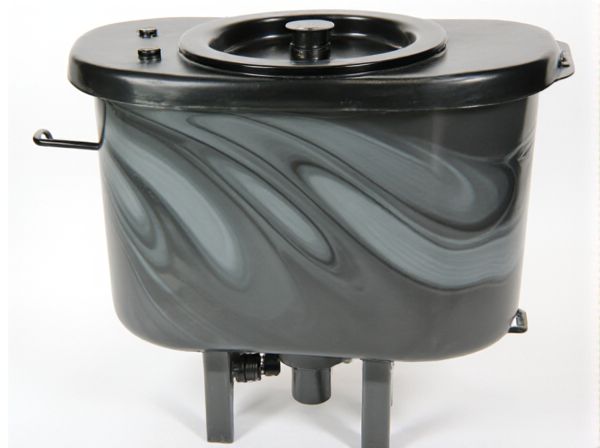
Photo illustration: Swirl Pot Tank vs Standard Tank
A swirl pot tank enhances fuel delivery by reducing air bubbles and maintaining consistent fuel pressure, which is critical for high-performance or racing engines. Standard tanks are simpler and more cost-effective but may suffer from fuel starvation during aggressive maneuvers or steep inclines. Choosing the right tank depends on your vehicle's demands and driving conditions, with swirl pots providing superior reliability in extreme situations.
Table of Comparison
| Feature | Swirl Pot Tank | Standard Fuel Tank |
|---|---|---|
| Fuel Delivery | Consistent fuel supply, reduces fuel starvation | Fuel level dependent, potential starvation on inclines |
| Design | Includes a small reservoir (swirl pot) near the fuel pump | Simple large-volume tank without internal compartments |
| Performance on Slopes | Maintains fuel supply even on steep angles | Fuel pickup can fail when tank tilts |
| Fuel Pump Protection | Protects pump from vapor lock and cavitation | Greater risk of vapor lock and pump damage |
| Cost | Higher manufacturing and maintenance cost | Lower cost, simpler design |
| Application | High-performance, off-road, and racing vehicles | Standard passenger and commercial vehicles |
Introduction to Fuel Tank Designs
Swirl pot tanks feature a compact reservoir designed to maintain a steady fuel supply by preventing air bubbles and fuel starvation during high-performance or off-road driving conditions. Standard tanks typically have larger capacities but may experience fuel sloshing and inconsistent fuel delivery when subjected to aggressive vehicle movements. The swirl pot design enhances fuel system reliability by ensuring continuous fuel availability in demanding environments, making it ideal for motorsports and rugged terrains.
What is a Swirl Pot Tank?
A Swirl Pot Tank is a specialized fuel reservoir designed to improve fuel delivery by preventing air bubbles and fuel starvation in high-performance or off-road vehicles. It features a small, cylindrical design that creates a swirling motion, keeping fuel constantly agitated and ensuring consistent flow to the engine. This contrasts with a Standard Tank, which lacks agitation mechanisms and can experience fuel delivery issues during sharp turns or uneven terrain.
Defining the Standard Fuel Tank
The standard fuel tank is a baseline storage container designed to efficiently hold and supply fuel in vehicles without specialized internal modifications. Unlike swirl pot tanks, standard tanks lack features that promote fuel movement or reduce air entrainment, relying solely on gravity and basic fuel pump mechanisms. This design offers simplicity and cost-effectiveness but may encounter challenges in maintaining consistent fuel delivery during high-performance or steep-angle driving conditions.
Key Differences: Swirl Pot vs Standard Tank
Swirl pot tanks are designed with an internal swirling chamber that prevents air entrainment and ensures consistent fuel delivery, whereas standard tanks typically rely on simple reservoirs without specialized flow control. Swirl pot systems enhance fuel system reliability by maintaining a constant fuel supply to the engine, especially in high-performance or off-road applications. Standard tanks are more common in everyday vehicles but may experience fuel starvation during steep turns or uneven driving conditions.
How Swirl Pot Tanks Prevent Fuel Starvation
Swirl pot tanks prevent fuel starvation by maintaining a consistent fuel supply to the engine regardless of vehicle orientation or acceleration forces. Their design circulates fuel within a small, separate reservoir, ensuring the fuel pickup remains submerged even during sharp turns, steep inclines, or cornering. Standard tanks lack this feature, making them prone to fuel sloshing away from the pickup point, which can cause intermittent fuel flow and engine hesitation.
Performance Impact: Swirl Pot Tanks Explained
Swirl pot tanks significantly enhance fuel delivery by maintaining constant fuel pressure and preventing vapor lock, especially under high-performance conditions. Unlike standard tanks, swirl pots use a smaller chamber to trap fuel near the pickup point, ensuring a steady supply to the engine during sharp turns or rapid acceleration. This design improvement results in more reliable engine performance and better fuel efficiency for racing and off-road applications.
Application Scenarios for Each Tank Type
Swirl Pot Tanks excel in heavy-duty applications requiring separation of air and debris from fuel or lubricants, making them ideal for industrial machinery and marine engines operating under high-stress conditions. Standard Tanks offer versatile use for general fluid storage in automotive, agricultural, and residential systems where simplicity and cost-effectiveness take precedence over advanced filtration capabilities. Selecting between these tanks depends on operational demands: swirl pots ensure cleaner fluid delivery in contaminated environments, while standard tanks serve well in controlled, low-contamination scenarios.
Installation and Maintenance Considerations
Swirl pot tanks offer simpler installation due to their compact design and lower required piping complexity compared to standard tanks, reducing setup time and labor costs. Maintenance for swirl pot tanks is streamlined by easier access to internal components and fewer potential clog points, leading to less downtime and fewer service interruptions. Standard tanks may require more extensive cleaning procedures and larger spatial accommodations, which could increase maintenance effort and installation challenges in confined environments.
Cost Comparison: Swirl Pot vs Standard Tank
Swirl pot tanks typically have a higher initial cost compared to standard tanks due to their specialized design that enhances fuel delivery and minimizes air intake during extreme vehicle maneuvers. Maintenance expenses for swirl pot tanks can be slightly elevated because of additional components like the swirl pot itself, which require periodic inspection and cleaning. Standard tanks offer a budget-friendly option with lower upfront prices and simpler maintenance but may incur indirect costs related to fuel delivery inefficiencies in high-performance applications.
Choosing the Right Fuel Tank for Your Needs
Swirl pot tanks excel in maintaining consistent fuel delivery by minimizing vapor lock and fuel starvation during high-performance driving, making them ideal for racing or off-road applications. Standard tanks offer greater fuel capacity and simpler design, providing reliability and ease of maintenance for everyday vehicles and long-distance driving. Selecting the right fuel tank depends on your vehicle's performance demands, driving conditions, and maintenance preferences.
 caratoz.com
caratoz.com